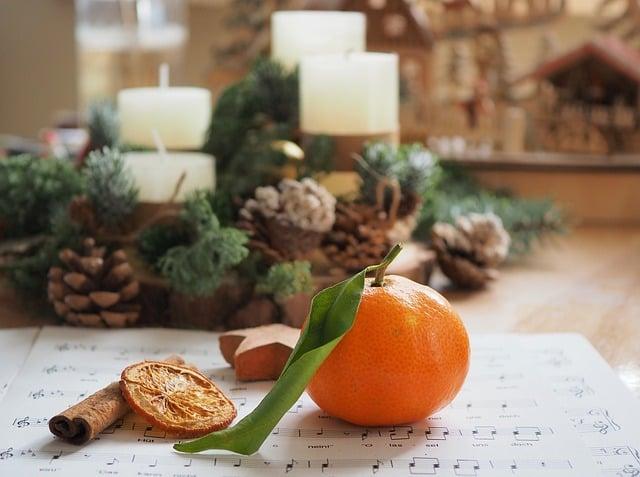As December dawned, a young girl named Clara eagerly opened the first door of her Advent calendar. Behind it, a tiny star glimmered, reminding her of the hope that filled the chilly air. Each day, she unveiled a new symbol: a candle for warmth, a gift for generosity, and a snowflake for the beauty of winter. With each reveal, Clara felt the anticipation of Christmas grow, a countdown not just to a day, but to a season of joy, reflection, and connection. The Advent calendar became her guide, illuminating the path to a deeper understanding of love and togetherness.
Table of Contents
- Exploring the Historical Roots of the Advent Calendar
- Unveiling the Spiritual Significance Behind Each Door
- Crafting Personal Traditions: Making Your Advent Calendar Unique
- Embracing the Season: How to Use the Advent Calendar for Reflection and Joy
- Q&A

Exploring the Historical Roots of the Advent Calendar
The Advent calendar, a cherished tradition in many households, has its roots deeply embedded in the Christian faith, tracing back to the 19th century. Originally, the concept of counting down the days to Christmas was manifested through various means, such as chalk marks on doors or the lighting of candles. These early practices were a way for families to prepare spiritually for the celebration of Christ’s birth. As the tradition evolved, the Advent calendar took on a more structured form, with the introduction of doors or windows that could be opened each day, revealing a small gift or a religious image. This transformation not only made the countdown more engaging for children but also reinforced the anticipation and joy associated with the holiday season.
Throughout the years, the symbolism of the Advent calendar has expanded beyond its religious origins, embracing a broader cultural significance. Each door opened represents a step closer to Christmas, symbolizing hope, joy, and the light that comes with the arrival of the holiday. The calendar serves as a reminder of the importance of patience and reflection during the Advent season. Today, Advent calendars come in various forms, featuring everything from chocolates to toys, yet they all share a common purpose: to foster a sense of community and togetherness. The act of sharing this daily ritual can strengthen family bonds and create lasting memories, making the Advent calendar a beloved tradition for generations.

Unveiling the Spiritual Significance Behind Each Door
Each door of the Advent calendar serves as a portal to a deeper understanding of the spiritual journey that unfolds during the season of Advent. As you open each compartment, you are not merely counting down the days until Christmas; you are engaging in a ritual that invites reflection and mindfulness. The act of unveiling a new door symbolizes the gradual revelation of hope, joy, and love, echoing the anticipation of the coming of Christ. This daily practice encourages individuals to pause and consider the significance of each moment, fostering a sense of gratitude and connection to the divine.
Moreover, the contents behind each door often carry their own unique symbolism, enriching the overall experience. Whether it’s a scripture verse, a small gift, or a simple image, these elements can represent various themes such as:
- Hope: Reminding us of the light that breaks through darkness.
- Peace: Encouraging a tranquil heart amidst the holiday hustle.
- Joy: Celebrating the blessings of community and family.
- Love: Reflecting the unconditional love that is central to the Christmas story.
By engaging with these symbols, individuals can cultivate a deeper spiritual awareness, transforming the Advent season into a meaningful journey of faith and reflection.

Crafting Personal Traditions: Making Your Advent Calendar Unique
Creating a personalized Advent calendar can transform the traditional countdown into a deeply meaningful experience. Consider incorporating elements that reflect your family’s unique story or values. For instance, you might include:
- Handwritten notes with personal messages or memories.
- Small tokens that represent shared interests, like miniatures of favorite books or hobbies.
- Acts of kindness that encourage giving back, such as donating to a local charity or volunteering together.
Additionally, think about integrating cultural or spiritual symbols that resonate with you. This could involve:
- Decorative elements that reflect your heritage, such as ornaments or colors significant to your background.
- Daily reflections that prompt discussions about gratitude, hope, or the values you wish to instill.
- Family traditions that are passed down, like sharing a favorite holiday recipe or story each day.

Embracing the Season: How to Use the Advent Calendar for Reflection and Joy
The Advent calendar serves as a beautiful reminder of the journey toward the festive season, inviting us to pause and reflect on the moments that matter most. Each day, as we open a new door or window, we are not just counting down to Christmas; we are also engaging in a ritual of mindfulness. This practice encourages us to embrace the present, allowing us to savor the small joys that often go unnoticed in our busy lives. By taking a moment each day to reflect, we can cultivate a deeper appreciation for the season and its significance.
Incorporating the Advent calendar into our daily routine can transform it into a source of joy and inspiration. Here are some ways to enhance this experience:
- Daily Gratitude: Use each day to write down something you are grateful for, fostering a sense of appreciation.
- Acts of Kindness: Plan a small act of kindness to perform each day, spreading joy to others.
- Mindful Moments: Dedicate a few minutes each day for quiet reflection or meditation, allowing for personal growth.
- Creative Expression: Engage in a creative activity, such as drawing or journaling, inspired by the themes of the season.
Q&A
-
What does the Advent calendar represent?
The Advent calendar symbolizes the countdown to Christmas, marking the anticipation and preparation for the celebration of the birth of Jesus Christ. Each day represents a step closer to this significant event.
-
Why are there 24 or 25 days on an Advent calendar?
Advent calendars typically cover the 24 days leading up to Christmas Eve, with some including Christmas Day itself, making a total of 25 days. This period reflects the four weeks of Advent in the Christian liturgical calendar.
-
What is the significance of the doors or windows on the calendar?
The doors or windows of an Advent calendar symbolize the unveiling of joy and hope as each day is opened. They often reveal a small gift, scripture, or image that enhances the spirit of the season.
-
How did the tradition of Advent calendars begin?
The tradition of Advent calendars dates back to the 19th century in Germany, where families would mark the days of Advent with chalk on doors or by lighting candles. The modern version evolved to include small gifts or treats behind each door, making it a cherished holiday custom.
As we peel back each door of the Advent calendar, we uncover not just treats and surprises, but a deeper connection to tradition and anticipation. This cherished ritual invites us to reflect on hope, joy, and the countdown to a season of giving.




